이것도 evilmad 에서 튀어나온넘으로 bristlebot 2탄이다.
그다지 그전것과는 다른건 없고, 단지 벨벳으로 디자인을 이~~쁘게 만들었다.
(그전에는 칫솔로 만들었으니 ^^)
A few weeks ago we showed you how to build a BristleBot, a tiny vibrating robot (vibrobot) that is formed from the unlikely union of a toothbrush (with directional bristles) and a vibrating pager motor. Despite its simplicity, it drives like a drunken bat out of hell-- propelled by the ratcheting action of the vibrated bristles.
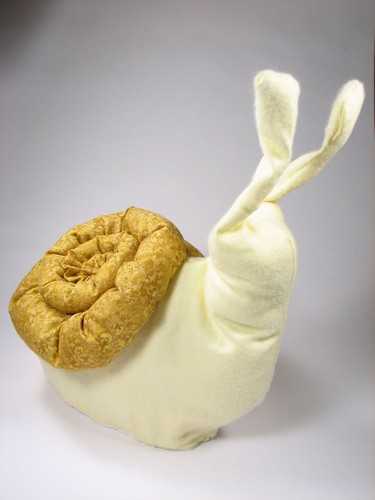
Of course, toothbrushes aren't the only system where you can find find oriented bristles. Approaching this process from an entirely different perspective, it turns out that certain types of velvet can also form a directional bristle system that can be driven with vibrations. Here we build a plush racing snail-- a velvet vibrobot that crawls forward... at a snails pace.
From http://www.evilmadscientist.com/article.php/snailbot
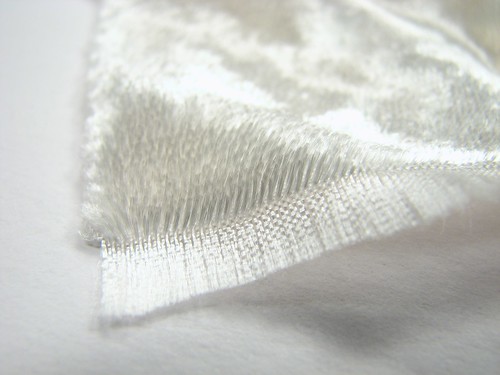
Here's a close up view of our velvet-- it has slightly slanted bristles.
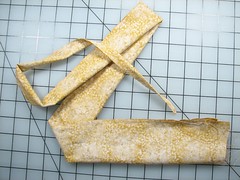
 For the shell, take a triangle of fabric about 6 inches wide, and about 4 feet long, fold in half and sew into a cone. Sew a running stitch along the inside of the seam allowance to use for gathering later.
For the shell, take a triangle of fabric about 6 inches wide, and about 4 feet long, fold in half and sew into a cone. Sew a running stitch along the inside of the seam allowance to use for gathering later. 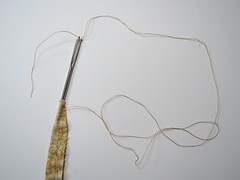
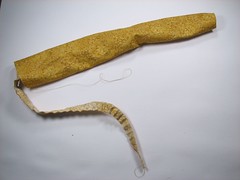

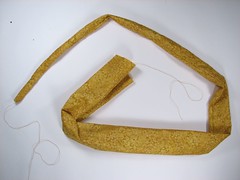 You can use a yarn needle to help in turning the cone right side out - just tie it to the extra thread on the end and drop it through to pull it out the other side. Since it is so long and narrow, you may want to start by turning as much right side out by hand as possible. I sewed my cone a little too narrow at the end, so it didn't quite all turn right side out, but that's okay, since it turns into stuffing for that end.
You can use a yarn needle to help in turning the cone right side out - just tie it to the extra thread on the end and drop it through to pull it out the other side. Since it is so long and narrow, you may want to start by turning as much right side out by hand as possible. I sewed my cone a little too narrow at the end, so it didn't quite all turn right side out, but that's okay, since it turns into stuffing for that end. 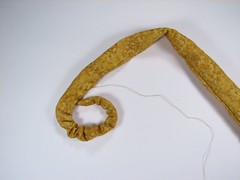
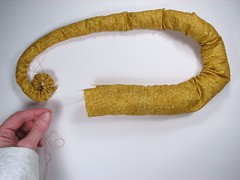
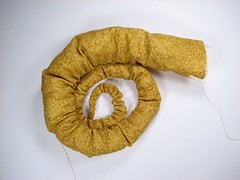
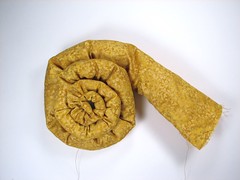 Stuff the snail shell loosely so that it can still bend easily. Pull the gathering thread and push the wrinkles to the small end to start it coiling up. Adjust the gathering to arrange the coil neatly.
Stuff the snail shell loosely so that it can still bend easily. Pull the gathering thread and push the wrinkles to the small end to start it coiling up. Adjust the gathering to arrange the coil neatly. 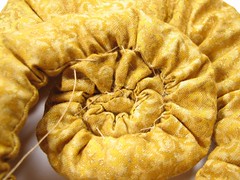
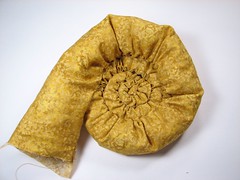 Sew the coils together on the back side, keeping the seam on the back as well. Leave a few inches unstitched.
Sew the coils together on the back side, keeping the seam on the back as well. Leave a few inches unstitched. 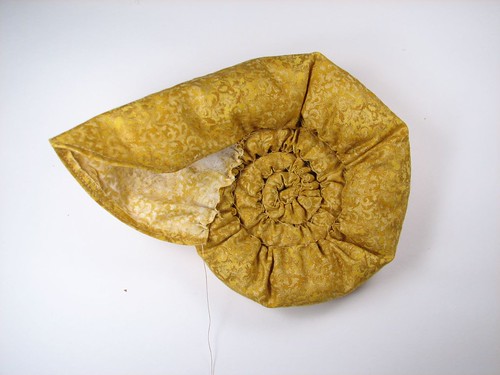
The shell will form a mantle over the shoulder of the snail. You can trim and sew down the border in a curve to make it neat.
Set aside the shell and move on to the motor.
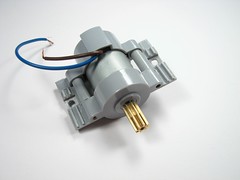

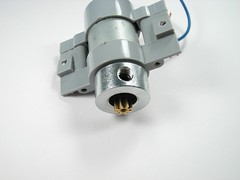
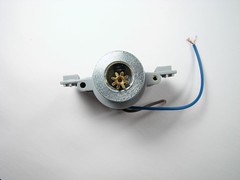 The motor is one that we took out of a cheap radio control boat-- just about any type of inexpensive DC motor will do. To make it shake, we attached a heavy shaft collar ($2.09 at the hardware store), off center, to the output shaft. If you happen to have a motor from a toy that already had an offset weight, that's fine too.
The motor is one that we took out of a cheap radio control boat-- just about any type of inexpensive DC motor will do. To make it shake, we attached a heavy shaft collar ($2.09 at the hardware store), off center, to the output shaft. If you happen to have a motor from a toy that already had an offset weight, that's fine too. 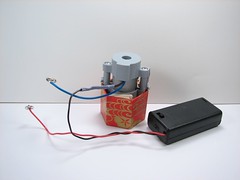
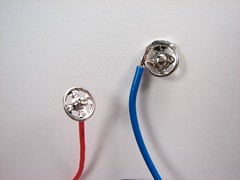
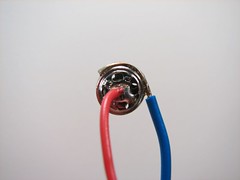
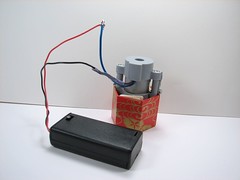 Here's one of the clever parts: This sew-on snap is the escargobot's power switch. It turns out that the nickel plating on the two sides of the snap is a well, snap to solder to. When the two sides of the snap are clicked together, the snail begins to move.
Here's one of the clever parts: This sew-on snap is the escargobot's power switch. It turns out that the nickel plating on the two sides of the snap is a well, snap to solder to. When the two sides of the snap are clicked together, the snail begins to move. 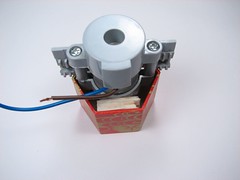
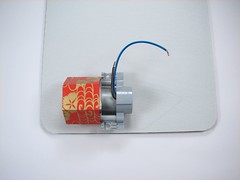 The offset weight needs an isolated area to spin without tangling in anything-- a little box over that end of the motor does the trick. In this case, the box needed some extra spacers to keep the motor centered-- a couple of small pieces of balsa.
The offset weight needs an isolated area to spin without tangling in anything-- a little box over that end of the motor does the trick. In this case, the box needed some extra spacers to keep the motor centered-- a couple of small pieces of balsa.
A mouse pad will form a semi rigid base for the motor to sit on.
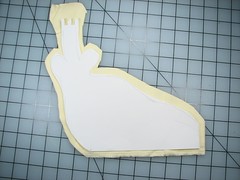
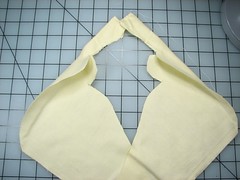
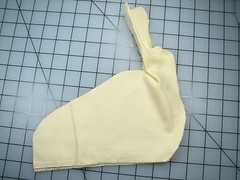
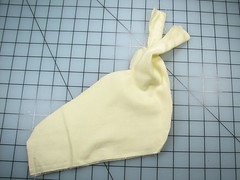 The snail body pieces look a little odd-- the funny bits sticking out on either side of the eyestalks help fill out the head. On each of the pieces, first sew the eye stalks and the seam across the top of the head. Next, sew the two pieces together from the top of the head to the front of the foot. Lastly, sew from the back of the head to the back of the foot.
The snail body pieces look a little odd-- the funny bits sticking out on either side of the eyestalks help fill out the head. On each of the pieces, first sew the eye stalks and the seam across the top of the head. Next, sew the two pieces together from the top of the head to the front of the foot. Lastly, sew from the back of the head to the back of the foot. 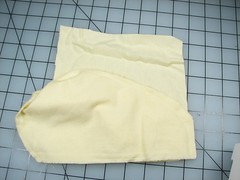
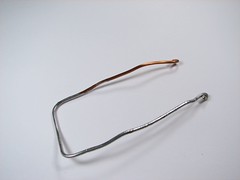 A rectangle of material will form a loose pocket inside to keep the stuffing material away from the motor, wires, and battery box. Sew along first one side, and then the other, leaving the ends of the pocket open to leave a method for adding stuffing later. As soon as you get it right side out you'll notice that you need a piece of wire to put into the eyestalks to make them posable. However, hold that stuffing thought until you've put the foot on.
A rectangle of material will form a loose pocket inside to keep the stuffing material away from the motor, wires, and battery box. Sew along first one side, and then the other, leaving the ends of the pocket open to leave a method for adding stuffing later. As soon as you get it right side out you'll notice that you need a piece of wire to put into the eyestalks to make them posable. However, hold that stuffing thought until you've put the foot on. 
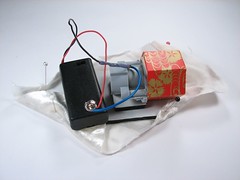 The motor is glued to the mouse pad with craft glue. An extra piece of mouse pad keeps everything balanced.
The motor is glued to the mouse pad with craft glue. An extra piece of mouse pad keeps everything balanced.
Pin your mouse pad with its motor to a piece of velvet and turn it on to get a feel for which direction it will go. Once you have it oriented correctly, trace around so you'll know where to attach your velvet foot.
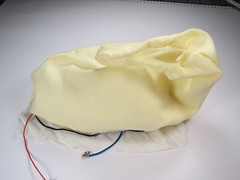
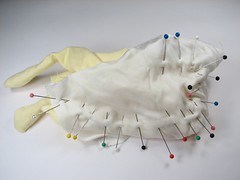
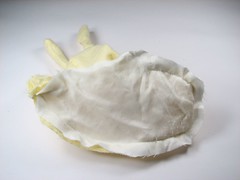
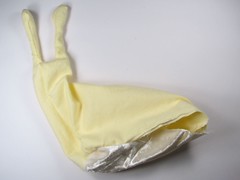 Everything should fit inside the pocket inside the snail body.
Everything should fit inside the pocket inside the snail body.
With the snail mostly inside out, pin the foot on around the line you've drawn. Sew it about two-thirds of the way around. When you turn it right side out, you should have a large enough opening left to put the motor in.
Time to stuff it! Insert the eyestalk wire and add sufficient stuffing to make a nice plump neck and body, leaving the bottom section hollowed out for the motor.

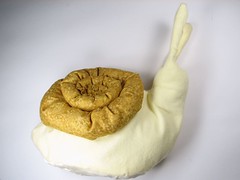 Pin the snail shell to the body and hand stitch in place.
Pin the snail shell to the body and hand stitch in place. 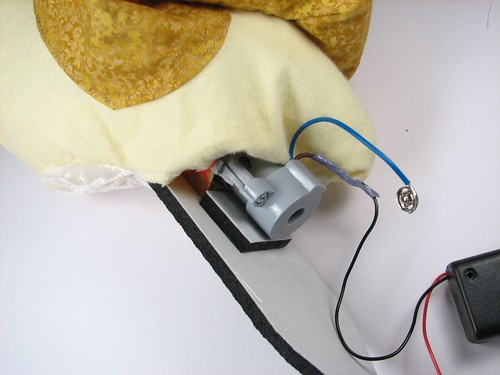
Insert the motor on its pad.
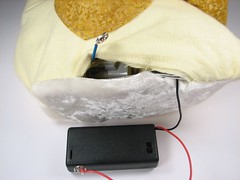
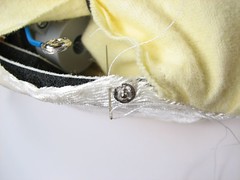
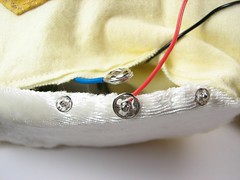
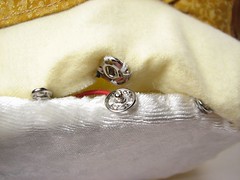 Arrange the motor so that the snap can reach the opening. Additional snaps may be necessary, depending on the size of your opening. Connect the snap to start up your racing snail.
Arrange the motor so that the snap can reach the opening. Additional snaps may be necessary, depending on the size of your opening. Connect the snap to start up your racing snail. 
And... VROOOOOOOMMMMMM!!!...er... crawl. Actually, it moves forward at a rate that's about right for a snail of this scale.
Velvet with a slight angle to the fibers works well for this application but other materials are possible as well-- some short fake furs and other plush fabrics have sufficiently directional strands to propel a plush toy. We think gastropods are probably the best choice of subject, but any small round critter could be adapted to a motorized version.
As always, if you make one, we'd love to see pictures in the Evil Mad Auxiliary on Flickr!